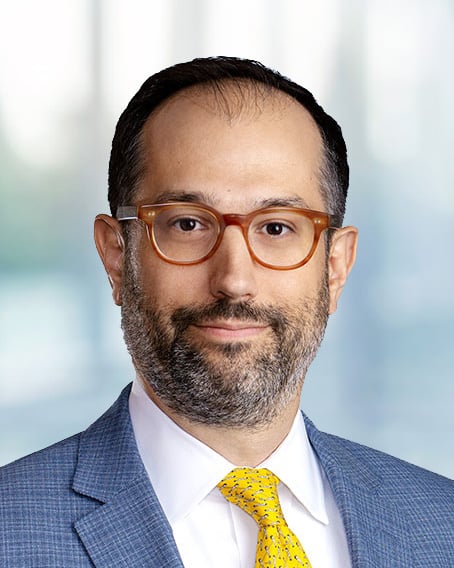In the latest installment of Ropes & Gray’s ETF podcast series, asset management partner Jeremy Smith, counsel Ed Baer and litigation & enforcement partner Dan O’Connor discuss some of the recent developments specific to the ETF wrapper itself, a potential twist on mutual fund to ETF conversions, and the recent ETF revenue sharing sweep.
Transcript:
Ed Baer: Hello, and thank you for joining us today on this Ropes & Gray podcast. I'm Ed Baer, a counsel in the San Francisco office of Ropes & Gray. Joining me today are two of my colleagues: Dan O’Connor, a partner in the litigation & enforcement practice group, and Jeremy Smith, a partner in the asset management practice group. In this podcast, which is part of a series of podcasts on ETF issues, we will discuss some of the recent developments specific to the ETF wrapper itself, a potential twist on mutual fund to ETF conversions, and recent SEC examination activity specific to ETFs.
Jeremy, can you tell us about some of the ETF-related conversations you’re having with clients these days?
Jeremy Smith: Sure. ETFs continue to experience strong flows despite recent market turbulence, especially compared to mutual funds. As they have for years, investors have been drawn to ETFs because of their relative tax efficiency, often lower operating costs, the ability to trade shares intraday using flexible order types, and the availability of ETFs in adviser model portfolios. On a prior podcast, we talked about the potential for mutual funds to convert to ETFs. We even wrote a whitepaper about it. Mutual fund to ETF conversions have continued to be announced, and our clients continue to inquire about mutual fund to ETF conversions—but as we discussed then and in our whitepaper, not every mutual fund is a good candidate to convert to an ETF.
Ed Baer: Can you elaborate on that? What makes a mutual fund a good candidate for conversion into an ETF?
Jeremy Smith: For starters, it’s important to look at the mutual fund’s shareholder base and class structure. If there are numerous share classes with different expenses and shareholder servicing structures tailored to different sales channels, converting to an ETF, where there is only a single share class, is more complex. From a practical standpoint, rolling several different classes into a single ETF structure means that shareholders of the different mutual fund share classes, who are in a particular mutual fund share class for a reason, will now be lumped all together in the single-class ETF. This will have a big impact on the mutual fund’s distribution and shareholder servicing arrangements, where different share classes may have been offered on different platforms with different compensation arrangements. Once they’re all in an ETF together, it’s one-size-fits-all. Mutual funds with simpler share class structures will be easier to convert to an ETF.
Ed Baer: That makes sense. I understand one additional complexity is that mutual funds may have direct shareholders, while retail ETF investors must transact using brokerage accounts. Getting direct mutual fund shareholders to open brokerage accounts to hold their ETF shares has proven challenging for some sponsors that have completed conversions. Also, another factor limiting the utility of certain mutual funds to convert to ETFs is retirement shareholders. Where a mutual fund has a significant number of retirement and/or 401(k) account shareholders, an ETF conversion might not be possible. Jeremy, why is that?
Jeremy Smith: Well, that’s for a few reasons. First, retirement investors don’t worry about taxes in the same way non-retirement investors do, so the tax-efficiency of ETFs is not as compelling. In addition, ETF shares can be traded intraday, which is unnecessary for retirement plan investors and can be problematic for some plans who prefer to have investment vehicles with a single price per day for all investors, as mutual funds do. Finally, ETFs are available only in whole shares, while 401(k) and other retirement accounts often transact in fractional shares as plan participants’ cash is invested. As a result, retirement shareholders don’t have any clear incentives to support mutual fund to ETF conversions. While mutual fund to ETF conversions remain a frequent topic in client conversations, these transactions don’t work for every mutual fund sponsor. However, that’s not the end of the story. Ed, can you talk about some of the related topics we’ve been discussing with clients?
Ed Baer: Certainly. We mentioned that ETFs consist of a single class. While this is largely true, certain Vanguard mutual funds are permitted to operate an ETF share class under an SEC exemption that only Vanguard currently possesses. That could stem, in part, from the fact that Vanguard patented the ETF share class structure. It has been widely reported that Vanguard’s ETF share class patent will expire in 2023, so clients have started to explore whether the SEC might be willing to permit other share class ETFs. Jeremy, can you talk about some of the challenges these efforts might face?
Jeremy Smith: Sure. The first challenge is that the SEC did not include share class ETFs when it adopted the ETF Rule, so share class ETFs, if permitted, will need to obtain separate Vanguard-style exemptive relief from the SEC. This is a meaningful obstacle as a lot has changed since the original ETF share class relief was issued, including the massive growth of the ETF industry and the adoption of the ETF Rule, among other things. Plus, when it adopted the ETF Rule, the SEC suggested that share class ETFs (and master-feeder ETFs) could raise issues regarding the appropriate allocation of transaction costs and tax efficiencies between the ETF and mutual fund share classes. Based on discussions we’ve had with the staff, we know the staff is willing to at least consider a carefully constructed and well thought out ETF share class exemption proposal that is designed to provide benefits to mutual fund and ETF shareholders, and then fairly allocate expenses and efficiencies across those share classes. We think there’s much that can be brought to bear in support of such an application, including the greater scale that can be obtained by managing all of the assets collectively and the elimination of certain duplicative costs that arise from managing the same strategy in different wrappers.
Ed Baer: Right. But that’s not the only way the fund industry is thinking about share class issues. We understand there’s an industry effort afoot to seek regulatory relief necessary for mutual funds to spin or split off share classes into separate funds—this will allow the funds to spin off individual share classes into stand alone ETFs without the transaction being taxable to fund shareholders. At issue is the applicability of Internal Revenue Code Section 355 to regulated investment companies (or RICs). While other business entities can rely on Section 355 to effect share class spinoffs on a tax-free basis, the industry effort is seeking clarification as to whether RICs can satisfy the requirements under Section 355 by engaging in the business of investing in securities. If there is any progress here, this could be big for ETFs, right?
Jeremy Smith: Absolutely. The ability to split off non-retirement class shareholders into an ETF and leave retirement shareholders in the mutual fund would provide another option for sponsors that want to get into the ETF business with some scale, but where a full mutual fund to ETF conversion will be too complex. This way, retirement shareholders can remain in the mutual fund while other shareholders can benefit from the move to the ETF structure.
Ed Baer: I noticed that you mentioned entering the ETF business at scale. Mutual fund conversions and spin offs provide potential opportunities for sponsors to create and grow their ETF businesses. This is because one of the big concerns of startup ETFs is obtaining seed capital. In the industry, the new norm is “bring your own assets.” ETFs are typically seeded with at least $1 million, and often with more than $2.5 million. In the early days of ETFs, it was common for a single AP or market maker to provide seed capital for an ETF launch, but after the financial crisis in 2008 and the Dodd-Frank Act, APs and market makers were more reluctant to tie up seed capital by seeding ETF shares. If the ETF doesn’t grow and achieve liquidity, a single AP or market maker often maintained those seed positions for six months or more, and these positions often represented over 80% of an ETF’s assets.
When a single firm holds significant percentage of an ETF’s shares, it raises concerns over the impact of potential affiliation and control issues on other funds in the ETF complex. To avoid this issue, many ETFs will arrange for two or more seed investors, including investors that do not operate affiliated broker-dealers. At times, the seed investor can be an affiliate of the ETF’s sponsor, but that might not be an option for many sponsors, so some firms may have to be more creative. Sometimes that involves finding a single client, such as a state pension plan, to provide seed capital. In some cases, ETF sponsors have entered into arrangements with seed investors that compensate a seed investor for providing seed capital or other services, such as product development and marketing consulting services.
Jeremy Smith: Thanks, Ed. That provides us a good segue into our next topic: revenue sharing. Dan, can you tell us what revenue sharing is?
Dan O’Connor: Sure, Jeremy. Revenue sharing refers to payments to broker-dealers, registered investment advisers, banks or other financial intermediaries typically related to marketing activities and presentations, educational training programs, conferences, the development of technology platforms and reporting systems, data services, or for making shares of a fund available to their customers. The payments are made by the fund advisers or its affiliates from their own resources and not from fund assets typically. However, payments or other financial incentives offered or made to an intermediary can create conflicts of interest between the intermediary and its customers, and may cause the intermediary to recommend the fund paying revenue share over another investment.
Ed Baer: That’s helpful. Traditionally, ETFs have not participated in revenue sharing arrangements to the same extent as mutual funds, but that may be changing. ETFs often enter into arrangements to get included on third party distribution platforms or to be considered for inclusions in advisers’ model portfolios. In addition, ETFs often make payments to third parties in order to obtain data about ETF users, including what types of investors use ETFs and how they use them. With ETFs increasing revenue sharing activity, the SEC has taken an interest. Dan, please tell us about the SEC’s recent revenue sharing sweep exam program.
Dan O’Connor: Sure. The SEC’s enforcement staff is conducting a sweep review regarding payments made by ETFs and their managers and sponsors to broker-dealers and other financial intermediaries. The staff has requested, among other things:
- A description of the payments made by the ETF, or the ETF’s managers or sponsors, to any third-party firms that market, buy, sell, distribute, or service the ETFs in question, including broker-dealers and registered investment advisers;
- The arrangements that set forth the terms and bases for such payments; and
- The details of the amounts of such payments made by the ETF manager broken out by the intermediary and period.
Our understanding is that the staff is focused for now on two principle issues: (1) what kind of services are being paid for out of the ETF versus the adviser’s or sponsor’s resources; and (2) whether the payments have been appropriately disclosed. In our experience, the staff’s focus has been on whether investors are informed appropriately about these payments and the potential for a conflict-of-interest that it creates. Some other commentators have also suggested, although the requests generally target ETF managers and sponsors, that the staff may be looking at the activity (and potentially the disclosures) of the financial intermediaries who receive these payments themselves, as well as whether broker-dealers are complying with their regulatory obligations they may have with respect to margin accounts.
Ed Baer: Dan, is it fair to say the SEC sweep presents an excellent opportunity for both ETF sponsors and financial intermediaries that pay or receive revenue sharing payments to revisit their disclosure practices regarding payments to intermediaries?
Dan O’Connor: Absolutely. As we note, we believe the SEC is for now focused on the disclosure of conflicts not only by the ETF sponsors, but also the financial intermediaries that receive revenue sharing payments. Since the SEC is focusing on the issue, the industry should be focusing on improving and reviewing its disclosure regarding these conflicts of interest, and take this opportunity now to address those.
Jeremy Smith: That brings us to the end of the podcast. Dan, Ed and I want to thank all of you for joining us on this discussion of recent ETF developments. For more information on the topics that we’ve discussed or other topics of interest to asset managers and ETF sponsors, please visit our website at www.ropesgray.com, where we have links to some additional material regarding these topics. To help you better understand the current ETF landscape, we will be issuing several additional podcasts designed to provide a greater depth of analysis on important and timely ETF issues. If you have any questions regarding the topics we addressed or anything else, please don't hesitate to get in touch with one of us or whomever you have a working relationship with at Ropes & Gray. You can also subscribe and listen to the series of podcasts wherever you regularly listen to podcasts, including on Apple and Spotify. Thank you again for listening.
Stay Up To Date with Ropes & Gray
Ropes & Gray attorneys provide timely analysis on legal developments, court decisions and changes in legislation and regulations.
Stay in the loop with all things Ropes & Gray, and find out more about our people, culture, initiatives and everything that’s happening.
We regularly notify our clients and contacts of significant legal developments, news, webinars and teleconferences that affect their industries.





